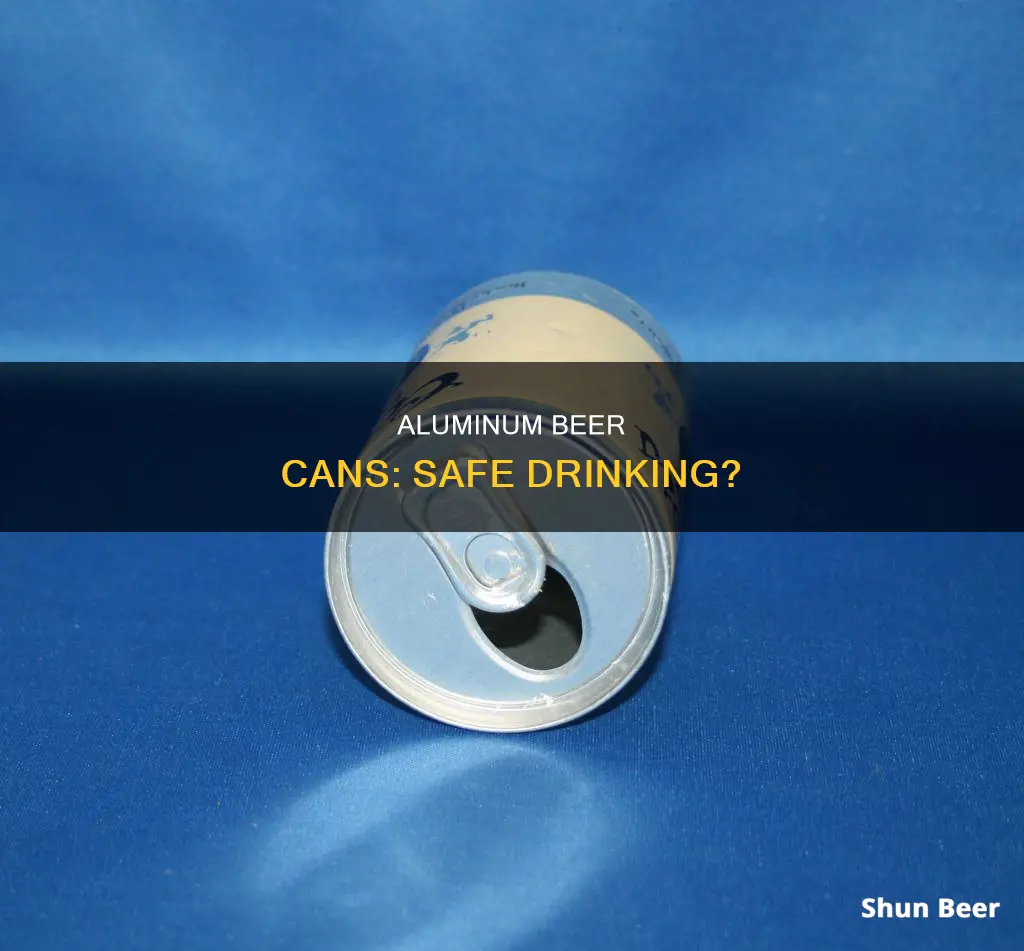
There are several health and safety concerns regarding drinking beer from an aluminium can. The outside of the can is exposed to germs and bacteria during the production process, and the aluminium itself may also be contaminated. Aluminium is toxic to human health and can migrate into food or drink when heated or if the food or drink is acidic. The plastic lining inside aluminium cans, which prevents the drink from touching the aluminium, is made from BPA (bisphenol A), which has been found to possibly cause hormonal imbalances and affect children's brains and prostate glands.
What You'll Learn

Aluminium cans are lined with a chemical called BPA (Bisphenol A)
Bisphenol A is a toxic chemical that has gained notoriety due to evidence that it can disrupt hormones that influence growth and development. In animal and epidemiological studies, researchers have linked BPA to breast and prostate cancer, reduced fertility, diabetes, genital defects, and altered behaviour. The Centers for Disease Control and Prevention found the chemical in the urine of 93% of US adults. Despite this, worldwide production and consumption of BPA have increased, although separate figures for North America show a small decline.
Due to consumer concern, manufacturers have moved to replace BPA with alternative chemicals. According to the Can Manufacturers Institute, about 95% of food cans are now made without BPA-based linings, using other coatings or polymers. However, it is unclear whether these alternatives are safer than BPA, as studies have identified the potential health impacts of some possible replacement chemicals.
BPA-based epoxy resins were identified in 67% of almost 200 food cans purchased across the US and Canada in a 2016 investigation by six non-profit groups. In 2017, the Center for Environmental Health also found that 38% of the cans they tested contained BPA-based linings, with a huge disparity in foods purchased in ethnic grocery stores, where BPA was present in more than 90% of can linings. However, by 2019, follow-up tests found that 96% of all cans were BPA-free.
While the use of BPA in canned food linings is decreasing, concerns remain about the lack of transparency regarding the substitute chemicals being used. It is important for consumers to be aware of the potential health risks associated with exposure to BPA and other bisphenol chemicals, and to make informed choices when purchasing canned goods.
Exploring Galveston Beach: Can You Enjoy Beer There?
You may want to see also

BPA is a possible cause of hormonal imbalances
Bisphenol A (BPA) is a synthetic compound that exhibits hormone-like properties and is found in many products, including polycarbonate plastics and epoxy resins. It is also commonly used in the production of aluminium cans, where it forms part of the plastic lining. Due to its widespread use, BPA can be found in the environment and in human tissues.
BPA has been classified as an Endocrine-Disrupting Compound (EDC) and a reproductive, developmental, and systemic toxicant. It can interfere with endocrine signalling pathways, even at low doses, and has been linked to various health issues, including hormonal imbalances.
BPA has a weak binding affinity for the estrogen receptors ERα and ERβ and can act as a xenoestrogen. This means it can interfere with and prevent the binding of natural hormones to their receptors and/or mimic hormones, thereby exaggerating the effects of endogenous hormones. BPA has been associated with an increased risk of hormone-related cancers, such as ovarian, breast, and prostate cancer. It can also induce resistance to various chemotherapeutic drugs and has been linked to other health issues, including insulin resistance, type 2 diabetes, and alteration of the normal immune response, resulting in high levels of Immunoglobulin E (IgE) and interleukin-4, which can lead to allergies.
In addition to its estrogen-like activity, BPA also binds to other nuclear receptors, such as the androgen receptor (AR). BPA can compete with 5α-dihydrotestosterone (DHT) to bind to the androgen receptor and has been shown to have anti-androgenic activity. This means it can prevent endogenous androgens from regulating androgen-dependent gene transcription, which can have an impact on hormonal balance.
Overall, the evidence suggests that BPA is a possible cause of hormonal imbalances and can have a range of detrimental effects on human health.
Beer and Clonazepam: Safe Mix or Risky Business?
You may want to see also

Aluminium is toxic to health
Aluminium is toxic to human health. We are living in the 'aluminium age', where human exposure to aluminium is inevitable. Aluminium's free metal cation, Al3+, is highly biologically reactive, and biologically available aluminium is non-essential and essentially toxic. It is present throughout the human body and, while rarely acutely toxic, much less is understood about chronic aluminium intoxication.
Chronic aluminium intoxication may be linked to Alzheimer's disease, breast cancer, and autism. However, there is no definitive evidence to support these claims. It is also unclear how to diagnose aluminium toxicity in an individual, as there are no unequivocal answers currently.
The Association de la santé et de l'environnement en France (ASEF) warns that aluminium in food packaging can migrate to food when heated and if the food is acidic. The longer the liquid remains in the can, the higher the risk of contamination. The European Food Safety Authority (EFSA) has set a maximum weekly dose of 1 mg/kg, which is exceeded by a significant portion of the European population.
The production of aluminium is also harmful to workers, with an increased risk of lung and bladder cancer. The process has been classified as a definite human carcinogen by the International Agency for Research on Cancer (IARC).
Additionally, the plastic lining inside beverage cans is made of BPA (bisphenol A), an endocrine disruptor. This has been banned in France but is still authorised in Switzerland and the United States.
Tramadol and Beer: Safe Mix or Health Risk?
You may want to see also

The outside of cans are exposed to germs and bacteria
The outside of cans is exposed to germs and bacteria. They go through a multitude of environments while being handled by multiple hands and carted around greasy industrial machines. In 2017, medical experts from the TV show *The Doctors* tested the tops of aluminium beverage cans gathered from gas stations, vending machines, and grocery stores. Although most came up clean, some from the grocery stores were positive for E. coli, which can cause diarrhoea, respiratory illness, and pneumonia. In 2013, a CBS TV station in Texas took swabs from the tops of cans in gas stations, restaurants, colleges, and vending machines and found harmful pathogens that can cause illness and infections in immunocompromised individuals.
The outside of cans is not the only part that is exposed to germs and bacteria. The inside of the cans can also be contaminated with microbes. This can happen when the cans are stored in warehouses that are not always protected from dust and other contaminants. Even if you pour the beer into a glass, the metal part on the outside may come into contact with the beer, and the microbes on it can contaminate the beverage.
To reduce the risk of exposure to germs and bacteria, it is recommended to wipe off the top area of a can before opening it, preferably with a clean cloth. Rinsing the can with water can also help to eliminate most of the harmful bacteria.
While the presence of germs and bacteria on the outside of cans is a concern, it is important to note that the likelihood of these contaminants causing serious health issues is relatively low. As microbiologist Jason Tetro explains, even if there are small amounts of contamination, most of the bacteria will likely be dead or diluted by the liquid being released from the can. Additionally, the human body can typically handle any minimal live germs that may be present.
Antihistamines and Alcohol: Safe to Mix?
You may want to see also

The likelihood of aluminium exposure is very low
Aluminium is toxic to health, and the ASEF (Association de la santé et de l'environnement en France) warns that aluminium in food packaging can migrate to food when heated and if the food is acidic. The EFSA (European Food Safety Authority) has set the maximum weekly dose that should not be exceeded at 1 mg/kg, while the exposure of Europeans is estimated to be between 0.2 and 1.5 mg/kg/week.
However, the likelihood of aluminium exposure from drinking beer out of an aluminium can is very low. According to Jason Tetro, a microbiologist and author of The Germ Files, the amount of chemicals leached from the cans cannot pose a health risk. He states that even if there is some contamination on the rim of the can, the likelihood is that most of the bacteria will be dead, and the small amount of live germs would be too minimal to cause any harm.
In support of this, Health Canada conducted a probabilistic exposure assessment in 2012, comparing chemical concentrations in food with consumption patterns of canned drinks and food. The assessment concluded that current exposure to BPA through packaging did not pose a health risk to the general population. Tetro further explains that for aluminium to pose a risk, one would need to ingest at least 1 milligram of aluminium per kilogram of body weight per day. For an 80-kilogram person, this would mean ingesting 80 milligrams of aluminium, while in reality, one would only be ingesting micrograms.
Therefore, while aluminium exposure is a valid concern, the likelihood of exposure from drinking beer out of an aluminium can is very low, and the potential health risks are minimal.
Beer and Lifting Weights: A Healthy Balance?
You may want to see also
Frequently asked questions
Drinking beer from an aluminum can is generally considered safe, but there are some potential risks to be aware of. It is recommended to rinse the can or wipe the top with a clean cloth before drinking.
Aluminum cans are often lined with BPA (Bisphenol A), which has been linked to possible hormonal imbalances and increased blood pressure. Additionally, the outside of the can may be exposed to germs and bacteria during the manufacturing and distribution process.
According to the EFSA (European Food Safety Authority), the maximum safe weekly dose of aluminum is 1 mg/kg. However, the average exposure for Europeans is estimated to be between 0.2 and 1.5 mg/kg/week.
Glass bottles are generally considered a safer alternative to aluminum cans. They are BPA-free and provide a clean, unadulterated flavor without the risk of metal contamination.
If you're concerned about the potential risks, you can choose to drink beer from a glass bottle instead. Additionally, wiping down the top of the can before opening it can help reduce the risk of bacterial contamination.







